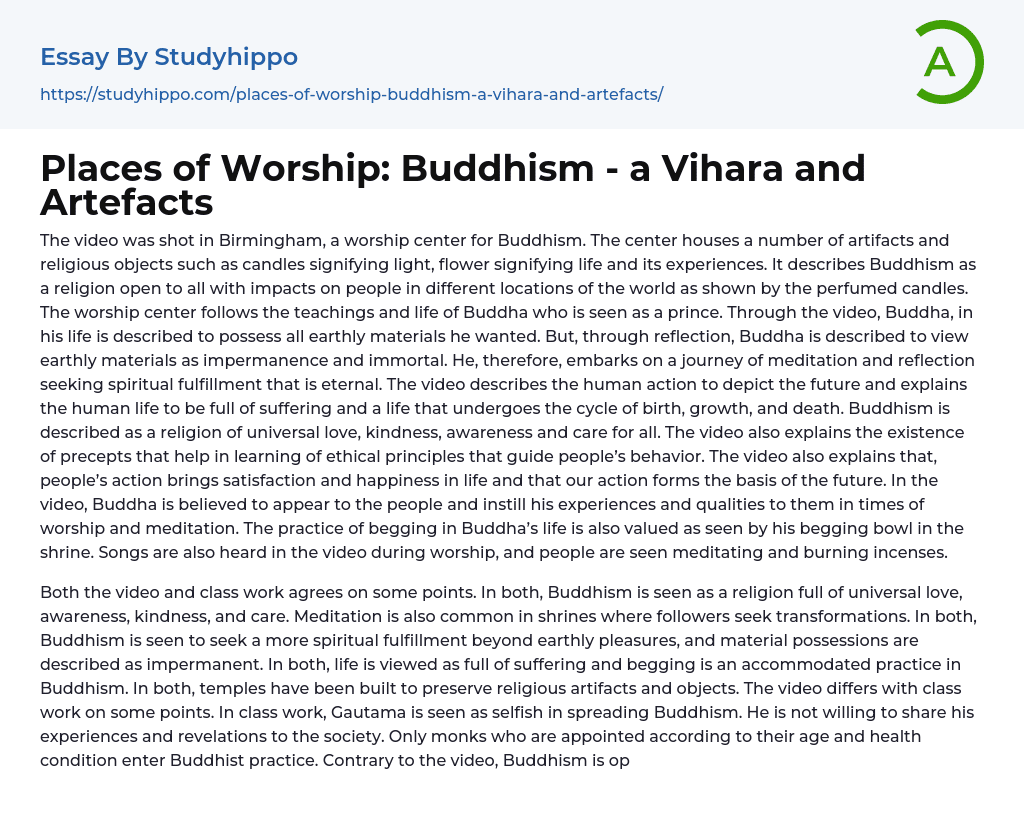

Places of Worship: Buddhism – a Vihara and Artefacts Essay Example
The video showcases a Buddhism worship center in Birmingham, where a wide array of artifacts and religious objects are housed. These objects include candles that symbolize light and flowers that represent the diverse experiences of life. The video highlights how Buddhism influences individuals from different regions worldwide, as depicted by the perfumed candles. Ultimately, this worship center follows and respects the teachings and presence of Buddha, who is revered as a prince.
The video depicts Buddha's life with desired worldly possessions, but he eventually realizes the impermanence and mortality of earthly materials through self-reflection. This realization leads him to embark on a spiritual journey through meditation and contemplation in search of eternal happiness. The video delves into how human actions shape the future and highlights that human existence is marked by suffering and the continuous cycle of birth, growth, and
...death. Buddhism is portrayed as a religion centered around universal love, compassion, mindfulness, and care for all beings.
The video discusses the presence of precepts that assist in grasping ethical principles that steer individuals' conduct. Furthermore, the video asserts that our actions yield contentment and joy in life, establishing the groundwork for the future. Budda's image is believed to materialize before individuals during worship and meditation, imparting his wisdom and virtues. The act of begging, an integral part of Buddha's life, is revered, evident in the presence of his begging bowl within the shrine. Additionally, songs are audible during worship, while people are observed meditating and burning incense.
Both the video and class work emphasize similar aspects of Buddhism. They both portray Buddhism as a religion characterized by universal love, awareness, kindness, and care. Additionally, both highlight the
practice of meditation in shrines as a means for followers to seek personal growth and transformation. Both sources also emphasize Buddhism's aspiration for spiritual fulfillment that transcends earthly pleasures, with the belief that material possessions are impermanent. Furthermore, both acknowledge the perception of life as inherently filled with suffering and the acceptance of begging as a practice within Buddhism. Lastly, both sources recognize the construction of temples as a way to safeguard and honor religious artifacts and objects.
The video and class work offer opposing viewpoints regarding Buddhism. In the class work, Gautama is portrayed as being self-centered for not sharing his insights and discoveries with society. It also suggests that only specific monks who meet certain qualifications are allowed to engage in Buddhist practices. Conversely, the video presents the argument that Buddhism welcomes individuals from all walks of life, regardless of their background or circumstances.
Siddhartha Gautamana, the founder of Buddha teachings, is portrayed as rejecting belief in a deity while also being worshipped as one by his followers. Personally, I find the video educational and morally inspiring. It underscores the significance of cherishing and nurturing both fellow humans and all living beings, stressing the importance of avoiding harm. Moreover, it accentuates the value of displaying compassion towards others and being mindful of one's actions towards them.
The video focuses on the universality of love and the significance of giving. It shows Buddha using his bowl to beg for food for himself and his friends, highlighting the importance of generosity. Additionally, the video demonstrates how religion serves as a guiding light for the world and recognizes its impact. As an educational resource, it offers insight into
Buddhist practices, artifacts, and symbols found in Buddhist shrines. The video includes scenes of meditation and worship sessions, providing viewers with the opportunity to observe these practices. Moreover, the songs featured in the video can be used to practice language within this context.
The video serves as a reminder that humans should not solely rely on earthly possessions and should instead focus on their spiritual growth and well-being. It emphasizes the universality of religion and how invoking a deity's name can bring spiritual fulfillment. Additionally, it highlights the importance and respect commanded by worship centers. Ultimately, the video urges viewers to be mindful of their actions as these shape their future.Ultimately, the video demonstrates that making correct choices will consistently yield contentment and joy in our lives.



